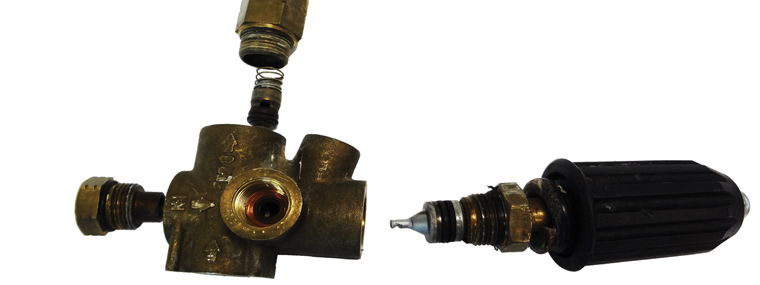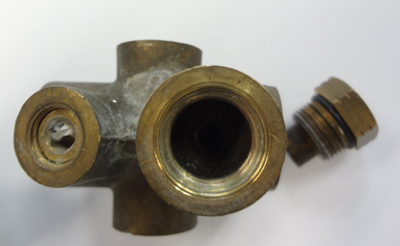
Unloader Valves: Gatekeepers in the Pressure Washer’s World
By Diane M. Calabrese

Gatekeepers prevent things from getting out of control. Colloquially, they are ticket agents at the jetway, security guards, and so on. In the physical world of fluids, valves serve as gatekeepers. Valve derives from valva (Latin, a leaf in a folding door).
Valves can be self-acting or mechanically actuated. The flap valve on a teapot’s spout is self acting; should pressure exceed what the (‘whistling’) hole in the flap can relieve, the flap opens some. There are many types of mechanically-actuated valves with two broad sorts—balanced and unbalanced—and many subtypes (and an extensive lexicon to match).
Beyond being used to control the flow of liquids, valves may be deployed to add to the safety of a device. The unloader valve in a pressure washer enhances safety and protects the integrity of components. When the nozzle of a spray gun is closed, an unloader valve sends water back to the inlet side of the pump (or into bypass). The un-loader may be activated by an increase in pressure or by a drop in flow.
Three experts talked with us about what contractors should know about unloader valves. They are: Ben Hagemann, purchasing manager at American Pressure, Inc. in Robbinsdale, MN; Gerardo González, product manager—professional pressure washers, Kärcher North America, Camas WA; Dr. Marlo Dean, senior support services manager, Kärcher North America, Camas, WA.
CT: What must a contractor understand about the role of the unloader valve in a pressure washer?
Hagemann: Its importance in safety and function.
González: It redirects the water discharged by the pump back to the pump inlet or back to a water tank—depending on the set up of the equipment—when the gun is closed. Contractors preferred configuration for mobile applications include large water tanks, and in this case, it is convenient to redirect the water back to the tank when in bypass to prevent pump overheating and maximize packing working life.
Dean: [Amplifying what González says, adds] Correct, but this could cause detergent to be pumped back to the water tank generating a large amount of foam, and the operator will not be able to rinse off their detergent depending on chemical siphoning configuration.
CT: What indicates there may be a problem with an unloader valve?
Hagemann: Unloader valves contain a return check valve. If the return check valve fails, the unloader will not go into bypass and ‘unload’ the pressure on the pump head. The pump will continue to pump at high pressure and build up temperature much faster—this not only puts the pump at risk of damage but will also show itself by load on the engine and motor.
Water leaks and inconsistent behavior are also signs of a potential failure in the near future.
González: The typical signal when there is an unloader malfunction is a reduction of flow through the nozzle, which results in pressure loss.
Dean: Typical symptom of an unloader failure is a sudden smooth pressure loss.
CT: Why do unloader valves fail?
Hagemann: There are a number of reasons unloader valves fail, even ways they can have a longer service life. Correct unloader selection, plumbing, and settings will generally give a long service life. Many valves have options for inlet ports; in many cases, the ratings change depending on which port you are using.
Using an unloader beyond its recommended settings and up to the maximum ratings will yield a shorter service life.
Unloaders are a mechanical part and will wear out just like any mechanical part. Lubricating the unloader every 20,000 cycles is recommended by some unloader manufacturers and will usually increase the valve life significantly.
González: Problems with unloader valves are commonly associated with the quality of the water being used. Solids in the water quickly deteriorate several parts in the pressure washer system, but the unloader valve is particularly sensitive to this condition. Small solids like sand grains are very abrasive and damage the metal seal in unloader valves, allowing more water to be bypassed, resulting in less flow through the nozzle.
Also commonly associated with unloader valve failure are multiple gun applications. Every time a gun in the system closes, the unloader valve needs to bypass the excess of water, so every gun in the system increases the amount of unloader cycles and the possibility of failure.
Dean: Over adjusting of the unloader, thereby creating a high spike pressure will damage the valve and seat. High water temperatures will damage O-rings and rings that are not rated for these high temperatures.
CT: Should a contractor ever take on doing a self-installation of an unloader valve?
Hagemann: Contractors have a living to make. Smaller contract cleaners often are do-it-yourself types with a great attitude toward getting the job done and making the equipment work. Larger contractors often have a mechanic on staff; sometimes it is just the handiest employee that gets assigned the repair task. There are good arguments to be made that having repair parts on site is a good business practice.
The unloader valve is the most complicated piece on a pressure washer and is a piece that is critical to safe operation. I would encourage any contractor to form a good relationship with their local dealer…Having local experts who can help you understand what has gone wrong and why will only serve to decrease part expenses and minimize downtime.
Dean: It has been my experience that the replacement and adjustment of unloader valves should only be performed by an experienced dealer or distributor to prevent wrong installation and adjustment errors.
CT: What are the basics of installation?
Hagemann: Installing the unloader with pipe connections is part of the installation, the easy part. The hard part is having the unloader set correctly. Too much tension on the spring and trapped pressure will increase and damage components, make for an unsafe situation, and possibly put employees in harm’s way.
On the milder side if the unloader is set a little too high and the nozzle is too small, the engine will be overworked.
When we install an unloader, we replace it with the same valve the manufacturer used. We also set the system pressure and check the trapped pressure. We look over the system to make sure all components are designed to run at the pressure setting and test the engine or electric motor to make sure it is not being overworked. High spike or high trap pressure are also important to consider.

Spike pressure can be high for a number of reasons. This can only be read with a transducer, but will show itself in failed fittings, hoses, and other unexplained short service life of parts. Trap pressure can be seen on a gauge and will give similar problems. The high pressures can be prevented with a properly working and properly set unloader valve.
It is important that whoever installs an unloader valve knows what they are doing and how a system works. I wouldn’t hesitate to say a contractor could install an unloader valve, but it would only be under the condition that they had proper training.
González: Removing a worn out or damaged unloader valve and installing a new one is fairly simple, however adjusting the preload on the bypass spring in the unloader valve requires a pressure gauge in the discharge side of the pump—anywhere between the pump outlet and the trigger gun. The gauge is used to make sure the trapped pressure while in bypass does not exceed the recommended limit of 200–500 psi above working pressure. Neglecting this important adjustment will result in low performance of the pressure washer. Not enough preload equals too much water bypassed, which equals reduced flow through the nozzle.
On the other hand, excessive preload will cause high pressure spikes and excessive trapped pressure; this condition might reduce the life of several pressure washer components. On electric machines, this might increase amperage draw and motor temperature. Experienced contractors using the right tools are able to adjust the preload properly and avoid these issues.
CT: What’s the one nugget to keep in mind regarding unloader valves?
Dean: Unloader valves must be selected specially for the flow and pressure. Choosing the wrong unloader valve for the application can be problematic and affects the operation and longevity. Improper adjustment will cause high spike pressures, which will damage the unloader valve and other components, which is why only trained service technicians should attempt to repair and service unloader valves.
I have experienced people making adjustments on unloader valves without using a pressure gauge. They just turn the adjustment going by the feel from the spray gun. This procedure is asking for premature failure of the unloader valve and other components damaged by high spike pressure.
Endnote: The Technical Committee of the Cleaning Equipment Trade Association (CETA) is in the process of consolidating information from all manufacturers on unloaders. Once uniformly formatted, information will be available to distributors as a technical reference (to train and to ensure proper component selection and function.)





